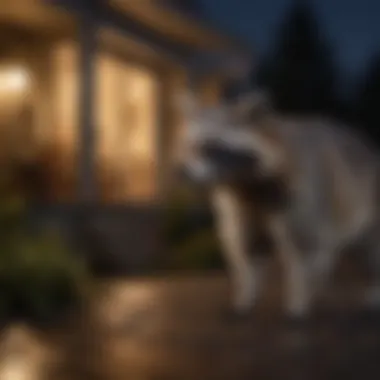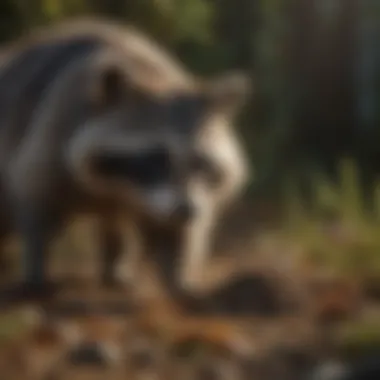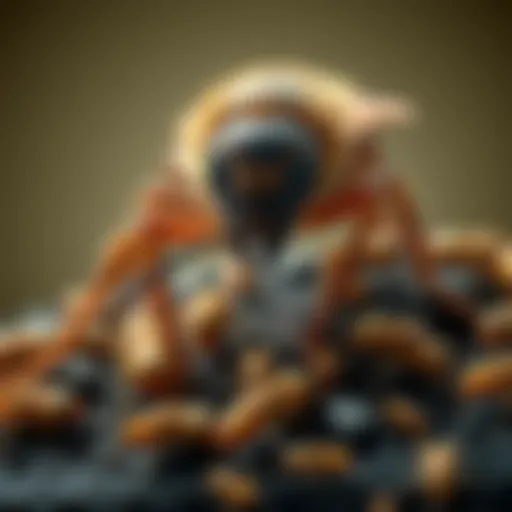Understanding Raccoons: Behavior and Management at Home


Intro
Raccoons are increasingly becoming a common sight in suburban neighborhoods. Their adaptability and intelligence allow them to thrive in areas close to human habitation. This article aims to unpack the complexities of raccoons around residential properties, emphasizing their behavior and the implications for homeowners. Understanding these aspects is crucial for effective management and coexistence.
Many homeowners might see raccoons as mere pests, yet they play significant ecological roles, such as seed dispersal and controlling insect populations. Recognizing both the benefits and challenges they pose is vital in developing a balanced perspective on wildlife interactions.
In the following sections, we will explore how to identify the presence of raccoons, preventative measures to avoid conflicts, and treatment options if control becomes necessary. By understanding raccoon behavior, homeowners can foster a safer living environment, minimizing disturbances and potential hazards.
Understanding Raccoons: A Brief Overview
Raccoons are often seen as urban dwellers, regularly found scurrying around residential properties. Understanding them is crucial for homeowners, particularly for those living in suburban or rural areas. This overview provides insight into raccoon biology, behavior, and habits, allowing individuals to navigate their presence effectively. An informed approach can minimize conflicts and promote safe coexistence.
Biology and Physical Characteristics
Raccoons belong to the Procyonidae family and are mammals native to North America. They typically weigh between 10 to 30 pounds, with adults averaging around 20 pounds. Their distinctive characteristic is the black mask of fur across their face and their ringed tails.
Physically, raccoons are well-adapted for survival. They possess dexterous front paws, enabling them to open containers and manipulate food. Their eyesight is excellent in low light, making them adept nocturnal foragers. Recognizing these traits helps homeowners understand the potential capabilities of raccoons around their property.
Habitat Preferences and Behavior
Raccoons are versatile creatures. They thrive in diverse environments, including forests, urban areas, and suburban neighborhoods. They typically seek habitats with adequate food sources, such as garbage cans, pet food, or gardens. Raccoons are primarily nocturnal, foraging at night to avoid human conflict.
Their behavior is often marked by curiosity, leading them to investigate enclosed spaces, like attics and basements. Understanding their behavioral patterns helps in recognizing potential intrusion and devising effective preventative measures.
Dietary Habits
Raccoons are omnivorous, consuming a varied diet that includes fruits, vegetables, insects, and small animals. They are known for rummaging through trash bins, looking for easily accessible food. Homeowners may find that securing waste is a fundamental strategy in preventing raccoons from being attracted to their property.
Their opportunistic feeding habits make them a common nuisance in suburban settings, as they quickly adapt to food sources provided by human activity. Recognizing their dietary preferences allows for targeted strategies to minimize their impact on gardens and refuse areas.
Understanding raccoons can help homeowners deter them effectively. Being aware of their biology, behavior, and dietary needs is key.
The Ecological Role of Raccoons
Understanding the ecological role of raccoons is crucial for grasping their impact on local environments. Raccoons are not merely pests; they play significant functions that can benefit ecosystems in various ways. Their presence can indicate the health of an area, and their behaviors contribute to ecological balance.
Role in Ecosystem Balance
Raccoons are omnivorous animals that feed on a wide array of food sources. This dietary versatility helps control populations of insects and small animals, which can otherwise overwhelm local ecosystems. By preying on these organisms, raccoons contribute to maintaining the balance within food chains.
Moreover, raccoons are significant seed dispersers. As they eat fruits and berries, they inadvertently transport seeds to different locations through their feces. This process aids in plant propagation and supports biodiversity. By facilitating the growth of various plant species, raccoons promote a healthier ecosystem.
Their role in recycling organic matter cannot be ignored. Raccoons often scavenge from human refuse and natural waste, which helps in breaking down decomposing materials. This action aids in nutrient cycling, enriching the soil and promoting plant growth. Therefore, the raccoon serves as an essential player in sustaining the health and vitality of their environments.
"Raccoons' scavenging habits support both soil health and biodiversity, making them integral to ecological processes."
Impacts of Raccoons on Urban Environments


In urban settings, raccoons can create a unique dynamic. While they may be seen as nuisances due to their scavenging behaviors around homes, they also offer insights into urban wildlife interactions. Their adaptability to city life showcases their resilience and ability to thrive in human-altered environments.
However, their presence in urban areas is not without challenges. Raccoons can demonstrate aggressive behaviors, especially when defending territory or young. They might also cause property damage by raiding garbage bins, which can annoy homeowners. Understanding these behaviors is critical for effective management strategies.
In terms of ecological benefits, raccoons in urban areas can help manage insect populations. As they forage for food, they might consume pests that would otherwise proliferate, minimizing the need for harmful pesticides. Moreover, their presence can encourage communities to appreciate and engage with local wildlife, fostering a sense of stewardship towards maintaining ecological balance even in urban landscapes.
Identifying Raccoon Presence Around Your Home
Recognizing the presence of raccoons around your home is crucial for several reasons. First, these animals can cause significant damage to property if they decide to make your house or garden their home. Second, understanding their behavior can help you mitigate potential health risks. Raccoons are known carriers of various diseases, including rabies and raccoon roundworm. By identifying signs of their activity, homeowners can take proactive steps to prevent intrusions and maintain a safe living environment. Moreover, understanding the patterns of raccoon presence enhances overall awareness and fosters a coexistence approach that benefits both humans and wildlife.
Common Signs of Raccoon Activity
Detecting raccoon activity involves recognizing specific behaviors and traces left by them. Common signs include:
- Tracks and Pawprints: Raccoons have distinctive paw prints. Their front paws have five toes, while the back paws have four. Look for tracks in mud or soft soil, especially leading to entry points.
- Scat: Raccoon droppings are typically cylindrical and can contain remnants of their eclectic diet, such as fruits and animal matter. Finding scat is a clear indication that raccoons are nearby.
- Damage: Check for any overturned garbage cans, torn bags, or disturbed bird feeders. Raccoons are excellent climbers and can access high places, so inspect trees and roofs for signs of disturbance.
- Noises: Raccoons are mostly nocturnal. Listen for sounds like scratching, chittering, or scurrying in the attic or walls during nighttime hours.
- Nesting Sites: Look for potential nesting areas. Raccoons may inhabit attics, chimneys, or sheds. Signs include visible entry points or debris accumulation near the potential nesting site.
Daytime vs Nighttime Behaviors
Raccoon activity is largely determined by time of day. Being aware of these behaviors can enhance your understanding of their habits.
- Nighttime Activity: Raccoons are primarily nocturnal. They search for food at night, utilizing their excellent night vision. During this time, they are more likely to raid garbage cans, forage in gardens, or approach houses for accessible food sources like pet bowls.
- Daytime Behaviors: While generally more active at night, raccoons can be seen during the day, especially if food sources are scarce. Daytime activity may indicate the presence of a food shortage in their usual foraging areas. Observing daytime behavior can prompt immediate attention to prevent further intrusions.
By closely monitoring these signs and behaviors, homeowners can better protect their properties and their health. Knowledge is a powerful tool in addressing potential raccoon issues, allowing individuals to act before problems escalate.
Potential Problems Associated with Raccoons
Understanding potential problems associated with raccoons is crucial for homeowners. Raccoons can create several challenges that range from property damage to health risks. Recognizing these potential issues allows effective management and prevents escalation into serious problems. Homeowners must consider these aspects to create a safe living environment, thus maintaining the integrity of their property and the well-being of their families.
Property Damage Risks
Raccoons are notorious for causing property damage. Their natural instinct to explore can lead them to raiding attics, garages, or sheds. When they find an entry point, they may tear away insulation, gnaw on electrical wires, or displace equipment. This exploration often results in costly repairs. Common areas affected include:
- Roofs: Raccoons can displace roofing materials to find shelter.
- Vents: They often enter through roof vents, damaging the structures.
- Garages and Sheds: Tools or storage may get damaged during their rummaging.
Due to their dexterous front paws, raccoons can open containers or doors easily. They may also raid pet food supplies, leading to further waste and loss. Keeping an eye on these areas can save significant expenses in restoration later.
Health Hazards and Disease Transmission
Raccoons also pose health risks, primarily through disease transmission. They are known carriers of several diseases that can be transmitted to humans and pets. Some of these include:
- Rabies: Though not common, raccoons are a significant rabies vector in North America.
- Leptospirosis: This bacterial infection can spread through contact with raccoon urine.
- Baylisascaris procyonis: A roundworm found in raccoon feces that can cause serious neurological issues in humans.
Contamination from raccoon feces or urine presents health hazards for humans and domestic animals. It may lead to serious health problems if proper sanitation is not maintained. Homeowners should exercise caution when handling areas where raccoons may have been active, ensuring they use protective gear if necessary.
Effective sanitation and awareness can mitigate many health risks associated with raccoons.
By addressing these potential problems proactively, homeowners can maintain both property integrity and family health.
Preventing Raccoons from Invading Your Property


Raccoons are intelligent creatures capable of adapting to various environments, especially urban ones. Their presence around houses can lead to conflicts and problems for homeowners. Therefore, understanding the best methods to prevent such invasions is essential. Effective measures not only safeguard your property but also help in creating a more harmonious relationship with local wildlife.
One key benefit of prevention is minimizing the risk of property damage. Raccoons can cause significant harm when they try to enter attics or basements. They often tear up insulation and chew through wires, leading to costly repairs. Furthermore, preventing raccoon visits also protects against health hazards that these animals may pose.
Effective Fencing Solutions
Building a sturdy fence is one of the most practical steps you can take. Raccoons are adept climbers, so it is vital to design a fence that is tall enough, ideally six feet or more. To enhance its effectiveness, consider adding an inward-angle at the top, which can deter climbing attempts. Moreover, ensure the fence’s base is buried at least a foot underground. This stops raccoons from burrowing under.
Securing Food Sources and Garbage
Raccoons are often attracted to easy food sources. Garbage cans can be a primary target. To mitigate this issue, use containers with tight-fitting lids. Metal cans are often more effective than plastic ones, as they are harder for raccoons to open. Additionally, consider securing compost piles or pet food areas. Store pet food indoors and refrain from leaving dishes outside overnight. Raccoons are opportunistic, so removing accessible sources of food can significantly reduce their interest in your property.
Structural Modifications to Deter Entry
Inspect your home for possible entry points. Raccoons can squeeze through surprisingly small spaces. Check the roof, vents, and chimneys. Closing gaps with sturdy materials such as metal mesh or boarding up holes can prevent access. Also, be mindful of tree branches that touch your roof. Trim them to reduce pathways for raccoons to climb onto your house.
"An ounce of prevention is worth a pound of cure." These efforts can save you from potential headaches in the future.
By incorporating these preventive strategies, homeowners not only secure their properties but enhance their understanding of raccoon behavior. This holistic approach helps maintain a balance between human habitation and wildlife presence.
Addressing Raccoon Encounters
Raccoons are resourceful creatures that often venture into residential areas in search of food or shelter. Addressing encounters with these animals is crucial for several reasons. First, understanding how to safely manage encounters can prevent property damage and health risks. Raccoons are known for their dexterous paws and keen senses, which allow them to access food sources and entry points with ease. Thus, knowing the appropriate management techniques becomes essential for homeowners.
Furthermore, educating homeowners about raccoon behavior and instilling a sense of respect for wildlife can lead to more harmonious coexistence. By implementing safe management techniques, individuals can enjoy their homes while minimizing potential disturbances caused by these nocturnal animals.
Safe Management Techniques
When dealing with raccoon encounters, safety is the top priority. Here are some effective techniques that can help manage raccoon activity safely:
- Minimize Attractants: Make sure to secure garbage cans and compost bins. Raccoons are drawn to food scraps and waste. Using raccoon-proof containers can significantly reduce their interest in your property.
- Non-lethal Deterrents: Utilize motion-activated lights or sprinklers. These devices can startle raccoons, encouraging them to look for food elsewhere. Additionally, consider using strong scents like vinegar or ammonia around areas they frequent, as these odors are typically unappealing.
- Safe Disturbance Techniques: If you encounter a raccoon in your yard, make noise from a safe distance. This may encourage the animal to leave on its own, avoiding direct confrontation which can be dangerous.
- Utilize Physical Barriers: Ensure fences are high and buried at least a foot underground to prevent burrowing. This creates a physical barrier against raccoons attempting to gain entry into your garden or yard.
"Understanding raccoon behaviors allows homeowners to manage encounters effectively without harm to the animal or themselves."
When to Contact Professionals
In certain situations, home management techniques may not suffice. Recognizing when to seek professional help is vital. Here are some key indicators:
- Repeated Encounters: If raccoons frequently return, this might indicate that they have established a den or nesting area nearby. Professional wildlife control services can provide strategies to evict them properly.
- Signs of Damage: If raccoons cause significant property damage, such as tearing apart roofs or siding, it’s essential to contact experts. They can help repair the damage while addressing the root causes of the encounters.
- Health Concerns: If a raccoon appears sick or injured, do not attempt to handle it yourself. Professionals have the training and tools necessary to deal with wildlife safely and effectively, ensuring both your safety and the raccoon’s well-being.
- Local Regulations: Many regions have specific laws regarding wildlife management. Consulting professionals ensures compliance with these regulations, preventing legal repercussions.
Contacting trained professionals allows homeowners to manage raccoon encounters responsibly and safely. Understanding when and how to seek assistance is a valuable part of living in harmony with wildlife.
Ethical Considerations in Raccoon Control
The need for ethical considerations in raccoon control has become significant due to the increasing interactions between humans and wildlife. As raccoons often invade residential properties, it is essential to manage their presence responsibly. Ethical approaches focus on avoiding harm to the animals and the environment while addressing human concerns.
Using humane methods helps maintain the balance between urban development and the natural ecosystem. It is crucial for homeowners to consider the well-being of raccoons, as they are intelligent creatures with complex behaviors. By implementing ethical practices, one can reduce the likelihood of harm and create a more peaceful coexistence with wildlife.
Humane Trapping Practices


Humane trapping is one of the most effective methods for managing raccoon populations in urban areas. These practices involve the use of live traps, which allow for the safe capture of raccoons without causing injury. When using humane traps, it is vital to:
- Choose the Right Trap: Select a trap designed specifically for raccoons, ensuring it is large enough for safe confinement.
- Use Proper Bait: Attract the raccoon by using food sources like fruits or cat food, which encourage them to enter the trap easily.
- Check Traps Regularly: Inspect traps frequently to minimize stress on the captured animal. Keeping the animal in captivity for long periods is unethical.
Once trapped, raccoons should be relocated to an appropriate habitat far from human habitation. It is critical to follow local guidelines regarding the relocation of wildlife, as improper handling can lead to further problems.
Legal Regulations Regarding Wildlife
Understanding legal regulations is essential for anyone dealing with raccoons. Many regions have specific laws that govern the trapping, relocation, and management of wildlife. Homeowners should be aware of these regulations to avoid legal issues:
- License Requirements: Some areas require permits for trapping wildlife. Homeowners must familiarize themselves with these requirements before taking action.
- Relocation Guidelines: It is often illegal to release captured raccoons on private property without permission. Guidelines generally dictate where and how to relocate these animals appropriately.
- Protected Species Considerations: In some locations, raccoons may be classified as a protected species. Special legal provisions may apply, necessitating consultation with wildlife authorities.
Always check with wildlife agencies or local ordinances to ensure compliance with laws regarding raccoon control.
In summary, ethical considerations in raccoon control are critical for fostering a respectful relationship between humans and wildlife. By opting for humane trapping methods and adhering to legal guidelines, homeowners can manage raccoon presence responsibly, ensuring both community safety and animal welfare.
Long-Term Solutions for Raccoon Management
Managing raccoon populations around residential properties is crucial not only for minimizing conflicts but also for enhancing the overall quality of urban wildlife interactions. Long-term solutions emphasize sustainable practices and community engagement, both of which ensure that residents can coexist with these animals while addressing the potential challenges they bring. This approach seeks to balance human needs with environmental considerations, paving the way for effective raccoon management into the future.
Sustainable Practices for Homeowners
Homeowners play a vital role in preventing raccoon invasions through various sustainable practices. Here are a few actionable steps:
- Secure Garbage: Regularly store garbage in raccoon-proof containers. Raccoons are often attracted to easily accessible food sources. Use bins with tight-fitting lids to deter them.
- Consider Landscaping: Remove any overripe fruit from gardens and keep landscaping neat. Dense vegetation can provide shelter and an invitation for raccoons.
- Wildlife-Friendly Fencing: If you own a garden, consider fencing that is both tall and extends underground. This deters digging and climbing.
- Eliminate Water Sources: Make sure your property does not have standing water. Raccoons need water for survival, and removing easy access can dissuade them.
Implementing these methods not only reduces raccoon encounters but also promotes a more thoughtful approach to living alongside wildlife. By fostering a raccoon-unfriendly environment, homeowners can significantly lower the chances of unwarranted interactions.
Community Outreach and Education
An educated community embodies a proactive approach to wildlife management. Informing residents about raccoon behavior and possible integration strategies is essential. Collaborative efforts can be beneficial in achieving long-term solutions. This can include:
- Hosting Workshops: Local wildlife organizations can initiate workshops to educate residents on raccoons’ habits and ecological roles. This knowledge empowers individuals to make informed decisions.
- Creating Resource Materials: Distributing pamphlets or guides that detail effective prevention methods can be a straightforward way to share vital information.
- Engaging in Social Media Campaigns: Utilize platforms like Facebook or community forums such as Reddit to share tips and experiences about raccoon encounters, thus amplifying awareness within any community.
"Education is key; communities that understand their wildlife neighbors tend to foster healthier and more harmonious environments."
Through these strategies, communities can evolve into informed allies rather than unwitting adversaries to the raccoons that inhabit shared spaces. Long-term management of raccoons depends on a multifaceted approach, where homeowner responsibility and community cooperation work in tandem.
Culmination: Navigating Coexistence with Raccoons
Understanding the dynamics of coexisting with raccoons is integral to managing their presence around urban and suburban properties. Homeowners often find themselves conflicted between their desire to preserve natural wildlife and the need to protect their homes from potential damages and health risks. This conclusion distills the key points from the previous sections and lays the groundwork for effective, harmonious relationships with these creatures.
Summary of Key Points
- Raccoons are adaptable and intelligent animals, often making them a common visitor in urban settings. Understanding their biology and behavior is crucial for homeowners.
- Preventative measures such as securing garbage and food sources can significantly reduce raccoon encounters. Adjusting structural elements, such as sealing entry points, also helps in deterrent efforts.
- In cases of encounters, employing safe management techniques is vital. If necessary, involving professionals ensures humane and effective handling of raccoon situations.
- The ecological role of raccoons should be appreciated. They contribute to local ecosystems, but conflicts can arise from their scavenging behaviors.
- Long-term solutions will require community engagement and outreach. Educational initiatives can foster a better understanding of wildlife management within neighborhoods.
Future Directions for Research and Management
Ongoing research is essential to improving raccoon management strategies and promoting coexistence. Future studies could explore:
- Behavioral Patterns: In-depth analysis of raccoon feeding habits, movement patterns, and social interactions can provide insights into their impact on local environments.
- Health Implications: Researching the transmission of diseases, such as rabies and leptospirosis, will help in developing health protocols to mitigate risks associated with raccoon encounters.
- Community Solutions: Identifying best practices for community-driven wildlife management can enhance efforts to coexist with raccoons and reduce human-wildlife conflicts. Collaborative programs could promote the use of humane strategies powered by community involvement.
In summary, effective coexistence with raccoons requires a combination of preventative measures, community involvement, and ongoing education. Building a deeper understanding of their behavior, impacts, and management techniques will benefit both homeowners and wildlife alike.
Promoting a balanced view of raccoons allows for sustainable practices that not only protect property but also respect the ecological significance of these adaptable animals. By fostering informed relationships with wildlife, homeowners can navigate coexistence more effectively.



